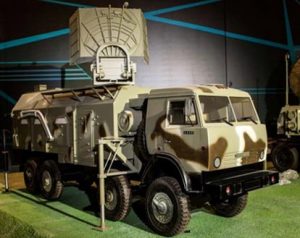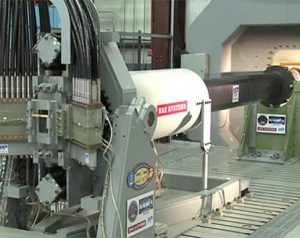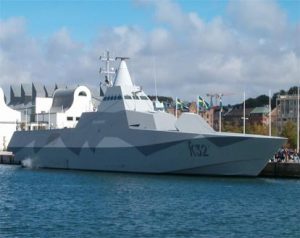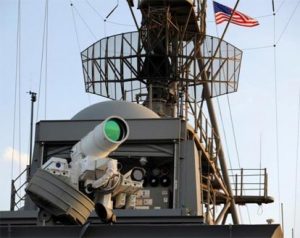Russia has announced its top 5 most effective electronic warfare (EW) Systems: Khibiny, Moskva-1, Krasukha-2, Rtut'-BM, and President-S. The Khibiny is a small torpedo shaped container that is mounted on wingtips of aircraft that increases the survival rate of aircrafts by 25-30 percent. After the aircraft has received an alert of a missile attack, the Khibiny covers the … [Read more...]
Military
U.S. Admiral Commends Navy’s Electromagnetic Rail Gun
Last month, the Navy ordered a new battery for its new electromagnetic rail gun as part of an $81 million dollar contract with K2 Energy Solution. “The Electromagnetic Railgun uses magnetic fields created by electrical currents to launch projectiles more than 115 miles,” the Office of Naval Research said. The U.S. Admiral praises the electromagnetic gun and laser due to its … [Read more...]
New COTS AC/DC Converter Announced
Astrodyne Corporation now offers a high power density COTS AC/DC converter in its Super MegaVerter series. The sMV500 series is ideal for use in thermally challenging applications and harsh aerospace and military COTS. This converter offers 500 W of power, high power density, an input range of 85 to 265 VAC, a frequency range of 47 to 440 Hz, an operating temperature range of … [Read more...]
IEC 62320-1 ed2.0
IEC 62320-1 ed2.0 has been released. The standard is titled "Maritime Navigation and Radiocommunication Equipment and Systems - Automatic Identification System (AIS) - Part 1: AIS Base Stations - Minimum Operational and Performance Requirements, Methods of Testing and Required Test Results." IEC 62320-1:2015(E) specifies the minimum operational and performance requirements, … [Read more...]
New Funding Provides Sweden With Electronic Warfare Technology-equipped Submarines
Exelis has been awarded a $17 million dollar contract to provide electronic warfare technology to services in Sweden. Under the contract, the company will provide submarines in Sweden with the latest model of the ES-3701 electronic warfare (EW) system to improve upon self-protection, situational awareness, surveillance and targeting. “The ES-3701 uses a circular array … [Read more...]
Navy Orders New Battery System for Electromagnetic Rail Gun as Part of $81 Million Deal
As part of an $81 million dollar contract with K2 Energy Solutions, the U.S. Navy recently ordered an intermediate energy storage battery system for the Navy’s new electromagnetic rail gun. According to the Office of Naval Research’s fact sheet about the powerful new weapon, the Navy’s electromagnetic rail gun uses magnetic fields, generated by electric currents, to fire … [Read more...]
Rugged COTS Yield Industry First
Curtiss-Wright Corporation has announced a new rugged air-cooled 3U 9-slot D2D chassis in a ¾ ATR Tall Long format, the Hybricon D2D-34TLA. The D2D-34TLA reduces program risk and costs, supports lab development, supports air/sea/field trials and deployment, speeds development, and simplifies inventory, according to the company. The D2D-34TLA can be used in demanding military, … [Read more...]
COTS AC/DC Power Module Works for Demanding Applications
Astrodyne Corporation introduces a compact, half-brick COTS AC/DC power module that offers high efficiency and reliability. The PFC-375 is ideal for use in military and commercial applications, as well as in shock vibration and harsh environments. “The PFC-375 offers high power factor, compliance with MIL STD 704 transient and MIL STD 461 and RTCA DO-160 total harmonic … [Read more...]
RF Power Combiners Improve Military and Commercial Solutions
Pasternack Enterprises, Inc. introduces a new line of broadband RF power combiners that operate up to 6 GHz. These new combiners are offered in 2-way and 4-way configurations and can deliver high power up to 600 Watts in temperatures ranging from 55 to 85 degrees Celsius. The RF power combiners are ideal for use in military and commercial applications. “With the addition of … [Read more...]
MIL-STD-1275D Compliant Surge Stopper Introduced
Linear Technology introduces the DC2150A, a MIL-STD-1275D compliant surge stopper. The DC2150A has an input operating range of 8V to 40V, and a 44V output clamp voltage. “DC2150A is designed to withstand input transients up to ±250V and to provide a minimum of 4A current to the load in all conditions except the ±7V ripple condition when the available current is reduced to … [Read more...]
- « Previous Page
- 1
- …
- 37
- 38
- 39
- 40
- 41
- …
- 84
- Next Page »














